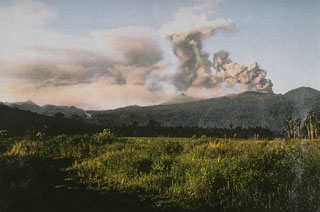Report on Dukono (Indonesia) — 14 December-20 December 2016
Smithsonian Institution / US Geological Survey
Weekly Volcanic Activity Report, 14 December-20 December 2016
Managing Editor: Sally Sennert.
Please cite this report as:
Global Volcanism Program, 2016. Report on Dukono (Indonesia) (Sennert, S, ed.). Weekly Volcanic Activity Report, 14 December-20 December 2016. Smithsonian Institution and US Geological Survey.
Dukono
Indonesia
1.6992°N, 127.8783°E; summit elev. 1273 m
All times are local (unless otherwise noted)
PVMBG reported that during 1 January-19 December white-and-gray plumes rose as high as 1.2 km above the rim of Dukono's Malupang Warirang crater, and were accompanied by roaring heard at the Dukono observation post 11 km away. The eruption plume height generally fluctuated though was higher during periods in May and from late November into December; ashfall increased during the periods of higher plume heights, and was noted in villages within 11 km N, NE, and SW. Seismcity at Dukono remained high. The Alert Level remained at 2 (on a scale of 1-4). Residents and tourists were advised not to approach the crater within a radius of 2 km.
Geological Summary. The Dukono complex in northern Halmahera is on an edifice with a broad, low profile containing multiple peaks and overlapping craters. Almost continuous explosive eruptions, sometimes accompanied by lava flows, have occurred since 1933. During a major eruption in 1550 CE, a lava flow filled in the strait between Halmahera and the Gunung Mamuya cone, 10 km NE. Malupang Wariang, 1 km SW of the summit crater complex, contains a 700 x 570 m crater that has also had reported eruptions.
Source: Pusat Vulkanologi dan Mitigasi Bencana Geologi (PVMBG, also known as CVGHM)

